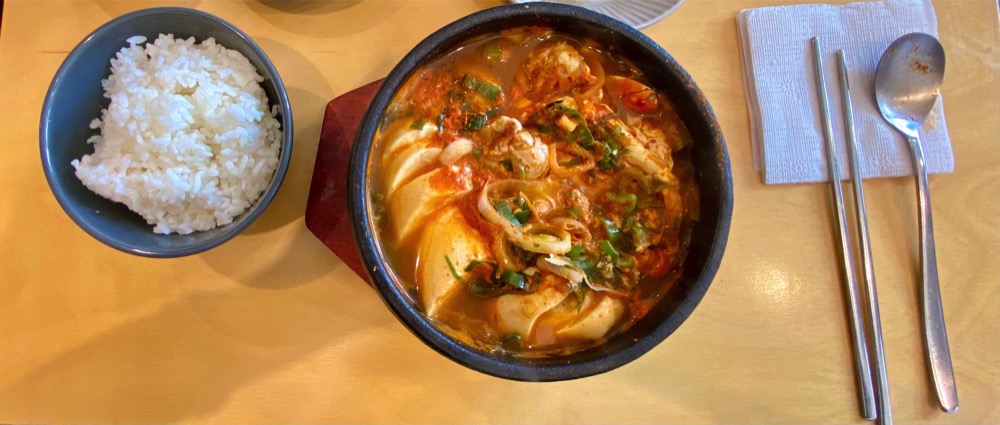SHARE
INFO
- DATE: 12-10-2020
- PLACE: Seoul
COUNTRY OF PROVENANCE

South Korea
RELATED ARTICLES

The girl on the 22nd floor – Alessandra in South Korea
I’ve always lived on the second or third floor of low-rise buildings. From the twenty-second floor, what is far away is much sharper. Alessandra, South Korea

My Tips – Seoul, South Korea
Seoul is a city to live rather than visit. Choose carefully where to go during the day and in the evening. What to see – my Tips – Seoul, South Korea
Gastronomy: a journey through the senses
Alessandra from Seoul, South Korea
Red
In addition to a “nest” overlooking our new little world, that will become more familiar day by day, what it takes to make a new city a “home” is a good relationship with the culinary local culture. Indeed, after almost ten years of living outside Italy and twenty of travels, I realized how this is a crucial point for Italians. We feel abroad even a few kilometers from home, when it comes to taste different dishes than our mothers’ ones, for instance.
First of all, what I remember of my impact with Korean cuisine is the red. Intense red like tomatoes from southern Italy, or like my eyes hanging out from their sockets after the first taste of squids in gochujang. Afterward, I discovered that this concentrate of chilli pepper is among the bases of nutrition in my new “home”. However, in a few months from that day, its spiciness enslaved me to the point of not being able to do without it.
Hence, this shows how hunger and sight cancel any information recorded by the mind in months of preparatory readings before departure. Additionally, how, after all, our being habitual allows us to initially adapt to survive and then live for real.

In search of the Comet Star: how sight guides taste
If taste was the protagonist of the impact with Korean cuisine, sight has often sent confused messages to the brain. After having experimented with little success from my sofa the search for the best restaurants within one kilometer from home and run through incomprehensible reviews of my new fellow citizens, I have resigned myself to go out on the street and start exploring my neighborhood at 40ºC at 8:00 pm. Here, the bright and vertical signs typical of Asian cities competed to attract my attention. Specifically, I had no idea of which delicacies each sign sponsored – I was not yet able to read Korean. Therefore, the most fanciful one was the Comet Star for a first exploration. In my eyes a continuous alternation of wonder in front of restaurants teeming with grills and cooker hoods as well as disappointment for the aseptic environment of metal tables, cutlery in drawers, paper napkins. Places more similar to refectories than to my idea of restaurants. Gas cylinders for the grills under each table that made a raspberry to safety. Not one, but dozens of these places to populate an entire dong – neighborhood – around Mapo. As a result, I was visibly confused by the messages those images conveyed and it was just then that another sense – hearing – entered straight leg into the scene.
Full immersion in the sounds around Korean flavors
Someone was talking to me, but I seemed not to notice; any word was simply a sound – or should I say noise (?) Meanwhile, the brain was paused trying to isolate itself and not spend energy trying to understand the incomprehensible. But suddenly, that sound became too close and intense to be ignored.
Here I am, a typical westerner -dazed and incapable to say no- climbing over groups of diners while following the typical ajoumma – Korean lady – and literally placed at a free table.
As a conclusion, I hadn’t chosen, I never could, but the place had chosen me, solving my dilemma. Finally, out of my bubble, I was wrapped – almost assaulted – by voices, loud laughter, crackling grids, contact between metal chopsticks, fast, confident and impatient movements of the waiters. I was fully into the typical Korean after-work.
Sociality at the basis of taste
In the time of a second, I was surrounded by banchan – side dishes whose variety distinguishes Korean cuisine à volunté – a triumph of color and flavor to wrap with the meat in salad or sesame leaves and eat in one bite. No knives in fact: the steak still on the grill is cut in small pieces with scissors to facilitate the use of the chopsticks. Perhaps it might have been the hunger or the enthusiasm following the initial disorientation, but I felt perfectly at ease in this new concept of shared dinner. Not very composed indeed, but certainly oriented towards sociability. Subsequentely, the barbecue will be the first impact with Korea for each and every of my guests: the way to get rid of the Italian idea of a beautiful and neat table, and go beyond our own schemes, immersing ourselves in food-taste sharing.
Finally feeling as a real Calabrian
The barbecue was just the beginning of this wonderful journey into the Korean cuisine. To illustrate, many among you will think that it was easy for a Calabrian to adapt to the dominant theme: spiciness. Yet, this time too, I have to destroy a stereotype: I am Calabrian, but I tried ‘nduja for the first time following my move to Milan at the age of 25, when my friends from the north insisted on receiving it as a gift on my return from my holidays in the south. Here, I came out and I imagine your eyes widening almost like mines at the first taste of Korean spicy food (see above). In fact, same happened to my new colleagues in front of my declaration of love for kimchi and doenjang jjighe.

Taste versus smell: fermentation at the heart of the battle
Kimchi is the basis of Korean cuisine; this fermented cabbage preserved with chili powder is often served as a banchan, but also as a main ingredient in more complex dishes. Instead, the main ingredients of doenjang jjighe (jjighe = soup, stew) are fermented soybeans. Hence, it should be easy to imagine what other sense is now making its entry into the scene.
The sense of smell of many Koreans – especially the younger ones – is bothered by this traditional dish due to the strong smell caused by fermentation. And how to blame them? As it arrives steaming on the table, it penetrates the nostrils and sticks to the brain. However, it is sufficient to have a little patience for the taste to prevail over the smell and for an Italian to conquer integration points in her new home, world of fermented wonders.
About me
Always in company of my camera, I like to tell about places and people through the light they absorb and reflect. My mouth cannot hold back the enthusiasm of my mind for what my eyes observe and the camera freezes in the memory. I am constantly looking for “beauty”: in places, experiences and above all in people. Curious by nature, I have often found beauty in differences, a gift that allows me to foster empathy and tolerance. As a dear friend of mine passionate about astrology would say, the precision of the Virgo is combined in me with the concept of enjoyable living of the Pig (in my Chinese horoscope), the organization with the ability to adapt to different situations. This mix contributes to make me a cheerful person loving company, especially around a good table full of delights from the world.
In the everyday life? Trained as a scientist, I have lived in several countries; I’m currently involved in science diplomacy in South Korea.
You can check out my pictures on flickr here.

